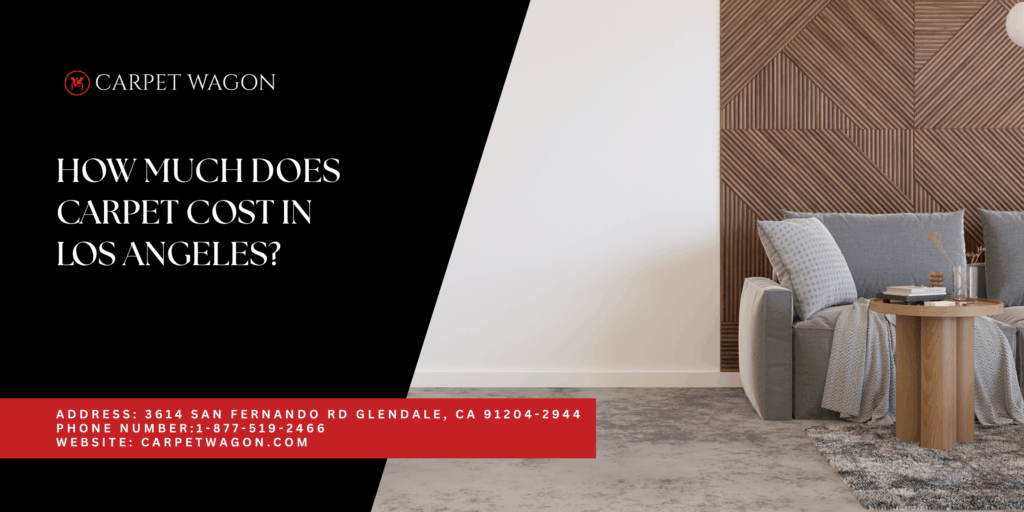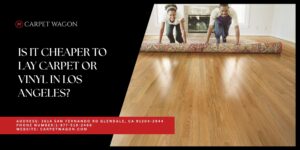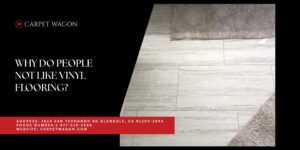“How much is this going to cost?” is the very first question every Los Angeles homeowner asks when they’re thinking about new carpet. And honestly, it should be. You’re making a significant investment in your home, and you deserve to understand exactly what you’re paying for and why.
The challenge is that carpet pricing in LA can feel like a mystery. You’ll see ads for “$1.99 per square foot carpet!” right next to quotes for $15+ per square foot. What’s the difference? Why such a huge range? And most importantly, what does “good carpet” actually cost when you include everything you need for a complete installation?
After fourty years of Carpet flooring installations across Los Angeles and providing transparent pricing to over 33,000 Los Angeles families, we’ve learned that the most satisfied customers are the ones who understand the complete picture before they start shopping. No surprises, no hidden costs, no confusion, just clear information that helps you budget accurately and choose wisely.
Let’s break down what carpet really costs in Los Angeles in 2025, so you can plan your project with confidence.
Table of Contents
ToggleThe Real Cost of Carpet: A Complete Breakdown
Before we break down the numbers, let’s talk about what really matters when it comes to carpet costs — from materials to installation. And we’re sharing this as trusted carpet store and service providers in Los Angeles, so you get the full picture before making a decision.
Part 1: What Drives the Carpet Price ($2 – $10+ per square foot)
Understanding Material Cost Factors:
Fiber Type – The Biggest Price Driver:
- Nylon Carpets ($4-$8/sq ft): The durability champion, excellent resilience, stain resistance, and longevity make nylon worth the investment for high-traffic areas
- Polyester ($2-$5/sq ft): The soft, budget-friendly option, great feel and color options at moderate pricing
- Olefin/Polypropylene ($2-$4/sq ft): The practical choice for moisture-prone areas like basements or covered patios
- Wool ($8-$15+/sq ft): The natural luxury, premium pricing for exceptional durability, comfort, and eco-friendliness
Style and Construction Factors:
- Pile Density: Thicker, denser carpets with more yarn cost more but last longer
- Pattern Complexity: Custom patterns, textures, and designer styles add to material costs
- Brand Positioning: Recognized brands often command premium pricing for reputation and warranty coverage
The type of fiber you choose is the biggest factor in your material cost. Learn about each fiber’s performance characteristics in our Carpet Types & Materials Guide.
Part 2: The Essential Extras Everyone Needs
Quality Carpet Padding ($0.75 – $1.50 per square foot): Here’s what most homeowners don’t realize: the padding under your carpet affects comfort, sound reduction, and carpet lifespan more than almost any other factor. Skimping on padding is like buying premium tires and mounting them on damaged rims.
Padding Investment Levels:
- Standard Rebond Padding ($0.75-$1.00/sq ft): Good performance for most residential applications
- Premium Memory Foam ($1.25-$1.50/sq ft): Superior comfort and sound absorption, worth it for bedrooms and family areas
- Moisture-Resistant Padding ($1.00-$1.25/sq ft): Essential for basements or areas with humidity concerns
Professional Installation ($1.50 – $3.00 per square foot): Quality flooring installation in Los Angeles is what transforms carpet and padding into a beautiful, long-lasting floor. This cost includes several essential services that protect your investment.
What Professional Installation Includes:
- Old Flooring Removal: Safe, proper disposal according to LA environmental guidelines
- Subfloor Preparation: Ensuring proper foundation for your new carpet
- Tack Strip Installation: Precise placement for proper carpet tension
- Expert Carpet Installation: Power stretching and professional seaming for longevity
- Furniture Moving: Professional handling of your belongings
- Complete Cleanup: Leaving your home spotless and ready to enjoy
Wondering what goes into professional installation? See the complete process in our Homeowner’s Guide to Installation.
Additional Services (Optional but Often Requested):
- Furniture Moving ($50-$200 per room): If not included in installation
- Stair Installation ($8-$15 per step): More complex installation requiring specialized skills
- Transition Strips ($15-$35 per linear foot): Professional transitions to other flooring materials
- Same-Day Installation ($100-$300): Rush service for urgent projects
Part 3: Real Los Angeles Pricing Examples (What You’ll Actually Pay)
“The Entry-Level Project” – Apartment or Rental Property 12′ x 12′ bedroom (144 sq ft) with durable, budget-friendly carpet
Material & Service Breakdown:
- Quality Polyester Carpet: $2.50/sq ft = $360
- Standard Rebond Padding: $0.75/sq ft = $108
- Professional Installation: $1.75/sq ft = $252
- Total Investment: $720 all-inclusive
What You Get: Soft, comfortable carpet with good stain resistance that will look good for 8-12 years with proper care. Perfect for bedrooms, guest rooms, or rental properties where budget matters most.
“The Mid-Range Family Home Upgrade” – Three Bedrooms Three bedrooms totaling 450 sq ft with family-friendly, stain-resistant carpet
Material & Service Breakdown:
- Premium Nylon or SmartStrand: $5.00/sq ft = $2,250
- Premium Padding: $1.25/sq ft = $563
- Professional Installation: $2.00/sq ft = $900
- Total Investment: $3,713 all-inclusive
What You Get: High-performance carpet with excellent stain resistance, superior comfort, and durability that will look beautiful for 12-15 years. Perfect for active families with kids and pets.
“The Premium Luxury Project” – Master Suite and Living Room Master bedroom and living room totaling 600 sq ft with luxury carpet
Material & Service Breakdown:
- Premium Wool or Designer Carpet: $12.00/sq ft = $7,200
- Luxury Memory Foam Padding: $1.50/sq ft = $900
- Expert Installation with Pattern Matching: $2.50/sq ft = $1,500
- Total Investment: $9,600 all-inclusive
What You Get: Luxury carpet with exceptional beauty, comfort, and longevity that will enhance your home’s value and provide decades of satisfaction. Investment-grade flooring for discerning homeowners.
Factors That Can Increase Your Project Cost
Room Complexity Considerations:
Stair Installation: Stairs require significantly more skill and time than flat installations. Expect $8-$15 per step for professional stair carpeting, including proper padding and expert stretching around each step.
Pattern Matching Requirements: Carpets with distinct patterns require careful planning and additional material waste to ensure proper alignment. This typically adds 10-15% to material costs.
Furniture Moving Complexity:
- Standard Furniture: Usually included in professional installation
- Heavy/Valuable Items: Piano, antiques, or built-ins may require specialty moving ($100-$300)
- Complete Room Clearing: Some installers charge separately for extensive furniture moving
Subfloor Issues: Older Los Angeles homes sometimes have subfloor problems that need addressing before carpet installation:
- Squeaky Floor Repairs: $150-$400 depending on extent
- Subfloor Leveling: $2-$4 per square foot for significant issues
- Moisture Barrier Installation: $1-$2 per square foot in basements or problem areas
Smart Budget Planning for Your LA Carpet Project
The Total Investment Approach: Instead of focusing only on carpet price per square foot, consider the cost-per-year over the carpet’s expected lifespan. This perspective often makes higher-quality materials a better value.
Budget Allocation Strategy:
- 60% – Carpet Material: The visible investment in comfort and appearance
- 20% – Quality Padding: Essential for performance and longevity
- 20% – Professional Installation: Protects your material investment
Financing Options Available: Many Los Angeles families take advantage of financing options to get better carpet now rather than waiting:
- Zero Payments/Interest for 1 Year: Available for qualified buyers
- Extended Payment Plans: Spread costs over 6-24 months
- Upgrade Financing: Trade up to better materials with manageable payments
How Los Angeles Pricing Compares
Regional Pricing Factors: LA carpet pricing reflects several local market realities:
- Higher Labor Costs: Skilled installers command appropriate wages in our competitive market
- Premium Material Availability: Access to high-end materials from major manufacturers
- Competitive Market: Multiple options keep pricing competitive while maintaining quality
- Local Building Requirements: Compliance with California building and environmental standards
Value Perspective: While LA pricing may be higher than some markets, the quality of available materials, professional installation standards, and long-term customer service support provide excellent value for your investment.
Avoiding the “Too Good to Be True” Trap
Red Flags in Carpet Pricing:
- Extremely Low Advertised Prices: Often exclude padding, installation, or other essential services
- High-Pressure Sales Events: Artificial urgency to prevent price comparison
- Unclear Service Inclusions: Vague about what’s included vs. additional charges
- No License or Insurance: Lower prices often reflect lack of proper business credentials
Quality Investment Indicators:
- Transparent, Itemized Pricing: Clear breakdown of materials, padding, and services
- Professional Credentials: Licensed, insured, established business practices
- Realistic Timelines: Quality work takes appropriate time and planning
- Written Warranties: Guarantee backing for materials and installation work
The Carpet Wagon Transparent Pricing Promise
What Makes Our Pricing Different: We believe in clear, upfront pricing that eliminates confusion and protects your budget. The price we quote during your in-home consultation covers everything you need for a complete, professional carpet installation.
Our All-Inclusive Approach:
- Single, Clear Price: No hidden costs or surprise charges
- Everything Included: Carpet, appropriate padding, professional installation, furniture moving
- Written Estimates: Detailed breakdown so you understand exactly what you’re paying for
- No-Pressure Environment: Make decisions comfortably without sales pressure
Why This Approach Works: After 40 years in Los Angeles, we’ve learned that the most satisfied customers are the ones who know exactly what to expect. Clear pricing builds trust and allows you to focus on choosing the perfect carpet for your home rather than worrying about hidden costs.

Budget Planning Made Simple
Questions to Help You Set Your Budget:
How Long Are You Planning to Stay?
- 5-10 Years: Focus on good performance at moderate investment
- 10+ Years: Consider premium materials for better cost-per-year value
- Forever Home: Invest in the best materials and installation for maximum satisfaction
Which Rooms Matter Most?
- High-Visibility Areas: Living rooms, main bedrooms deserve better materials
- High-Traffic Zones: Hallways, stairs need maximum durability
- Low-Use Spaces: Guest rooms, formal dining can use budget-friendly options
Family Lifestyle Factors:
- Active Families: Invest in durability and stain resistance
- Entertaining Focus: Choose materials that maintain appearance under social use
- Comfort Priority: Emphasize soft fibers and premium padding
Real Customer Investment Examples
The Young Family Approach (Burbank): “We chose mid-range nylon for our main living areas and budget-friendly polyester for the bedrooms. Total investment was $4,200 for 600 square feet, and three years later, we’re still completely happy with both choices.”
The Empty Nester Investment (Beverly Hills): “We went with premium wool for our living room and master bedroom, $8,500 for 400 square feet. It was a big investment, but the luxury feel and knowing it will look beautiful for decades made it worthwhile.”
The Budget-Conscious Strategy (Glendale): “We focused our budget on high-quality padding and professional installation with moderate-priced carpet. For $2,800, we got 500 square feet that feels much more expensive than it was.”
Ready for Clear, Accurate Pricing?
Stop guessing about what your carpet project will actually cost. Every Los Angeles home is different, and your pricing should reflect your specific rooms, material choices, and installation requirements.
Why wonder about pricing when you can get accurate, all-inclusive estimates in the comfort of your own home?
Schedule your free, no-obligation in-home consultation today! We’ll provide detailed, transparent pricing for your specific project, with no hidden costs and no pressure, just honest information that helps you make the best decision for your home and budget.
Call 1-877-519-2466 or visit carpetwagon.com to schedule your comparison consultation.
Proudly Serving pet families throughout Los Angeles, including Glendale, Pasadena, Burbank, Hollywood, Beverly Hills, Santa Monica, Manhattan Beach, and all surrounding communities. Licensed contractor #913187.





